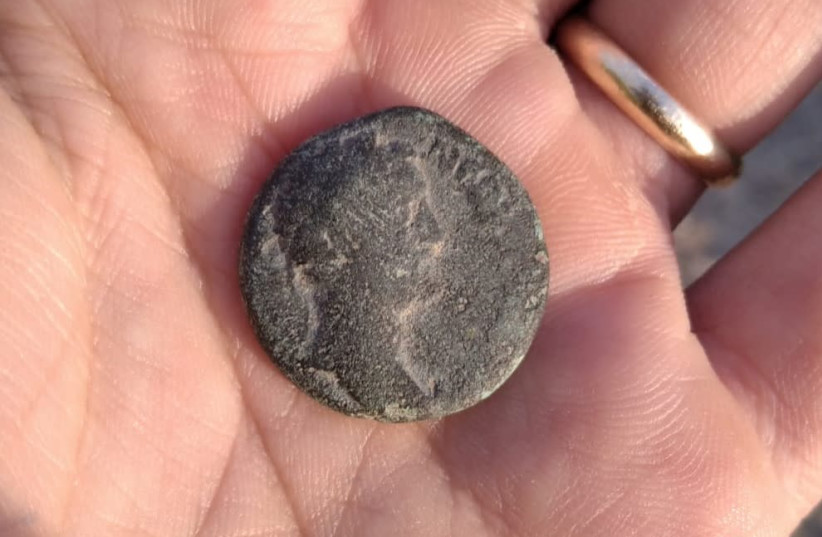 1800-year-old coin found by soldier offers look at ancient life in Israel
1800-year-old coin found by soldier offers look at ancient life in Israel
ROSSELLA TERCATIN
One of its sides reads “of the people of Geva Phillipi”, [civic] year 217 (158–159 CE) together with the image of the Syrian moon god Men. The other face carries the portrait of Roman emperor Antonius Pius.

Some 1,800-years ago, a traveler was making his way through the Carmel area and a coin fell from his pocket. Almost two millennia later, the artifact was found by an Israeli soldier during a training exercise, the Israel Antiquities Authority announced on Tuesday.
“This coin joins only eleven such coins from known locations in the National Treasures Department collection. All the coins were found in northern Israel, from Megiddo and Tzipori to Tiberias and Arbel,” Dr Donald Tzvi Ariel, head of the IAA’s Numismatics Department, said.
IDF soldier Ido Gardi with the coin he found in the Carmel area. (Nir Distelfeld/Israel Antiquities Authority)
The artifact bears images and text that allowed researchers to precisely identify its origin and dating: One of its sides reads: “of the people of Geva Phillipi”, [civic] year 217 (158–159 CE) together with the image of the Syrian moon god, Men. The other face carries the portrait of Roman emperor Antonius Pius.
“The coin discovered is one of the municipal coins minted in the city of Geva Philippi, also known as Geva Parashim,” Dr Avner Ecker, lecturer in classical archaeology at Bar-Ilan University’s Department of Land of Israel Studies and Archaeology, explained.
“In the Roman period, cities [poleis] were granted the right to mint their own coins. The year marked on the coin is the year when the municipal council, evidently, was established, and its citizens were allowed self-government under the Roman Empire.”
The settlement of Geva was already mentioned by first century historian Josephus, a Jewish soldier who eventually defected to Rome, whose works are considered a fundamental source on the Jewish revolt against the Romans and on life in the Land of Israel at the time. The ancient scholar located the town on the foothills at the edge of the Jezreel Valley, not far from the Carmel.
“Herod settled his cavalry forces there [hence the name Geva Parashim, “City of Horsemen”] and in the Great Revolt, in 66–70 CE, local and Roman forces set out from there to fight Jewish rebels near Bet She’arim,” Ecker noted.
The Syrian god MEN (the moon god) surrounded by the legend “of the people of Geva Phillipi”, civic year 217 (158–159 CE). (Nir Distelfeld, Israel Antiquities Authority)
“Some believe that Geva is located near Sha’ar Ha’amakim, but most scholars identify the site as Tel Abu Shusha, near Kibbutz Mishmar Ha’emek. Excavations conducted by Bar-Ilan University on the tell last summer unearthed remains of fortifications and buildings dating from the Hellenistic to the Byzantine period.”
Antonius Pius ruled over the Roman empire between 138 and 161 CE and earned the reputation of a just and humane sovereign. Among others, he repealed some of Rome’s harshest policies against Jews imposed by his predecessor, Hadrian.
Ido Gardi, the soldier who spotted the coin, received a certificate of appreciation for good citizenship by the IAA.
“This is an opportunity to call on any members of the public who have found coins, or any other ancient artifacts, to report them to the Israel Antiquities Authority,” said Nir Distelfeld, inspector for the IAA Northern District’s robbery prevention unit.
“We will come and transfer the find to the National Treasures Department, hopefully adding more data and enriching scholarly research with another piece of evidence from the past. It should be stressed that antiquities are national treasures, it is forbidden to actively seek them, and any chance finds must be reported to the Authority. The soldier, Ido Gardi, demonstrated exemplary civic behavior and we hope that he will act as an example for others who discover ancient finds.”
Zawartość publikowanych artykułów i materiałów nie reprezentuje poglądów ani opinii Reunion’68,
ani też webmastera Blogu Reunion’68, chyba ze jest to wyraźnie zaznaczone.
Twoje uwagi, linki, własne artykuły lub wiadomości prześlij na adres:
webmaster@reunion68.com
